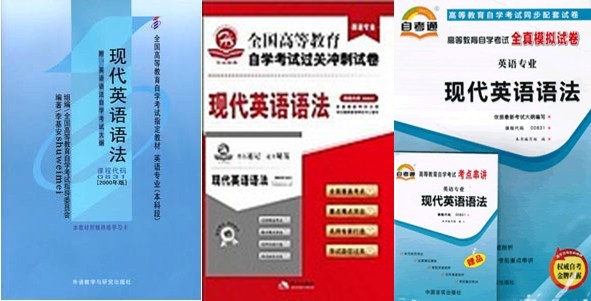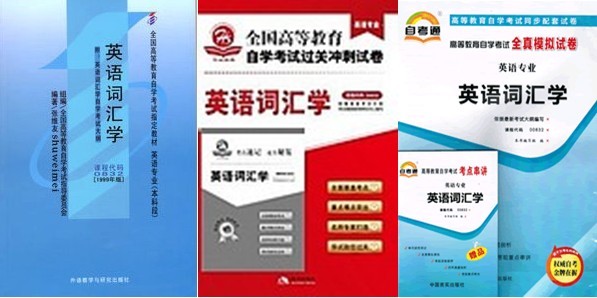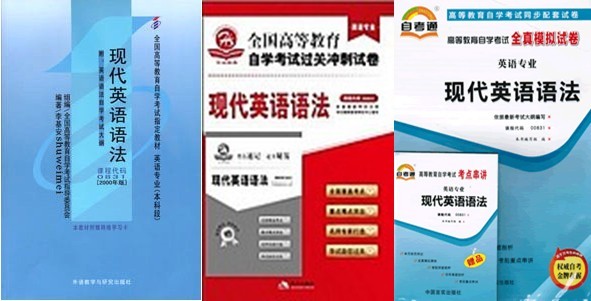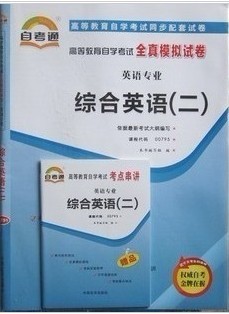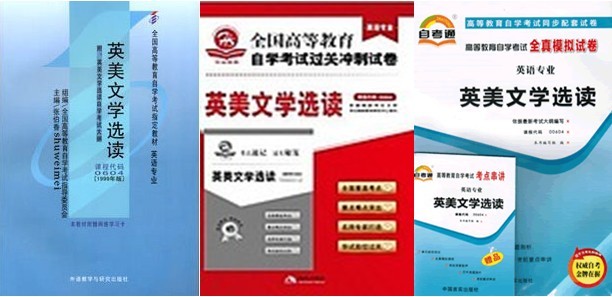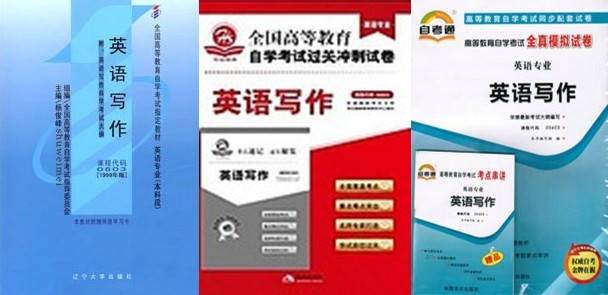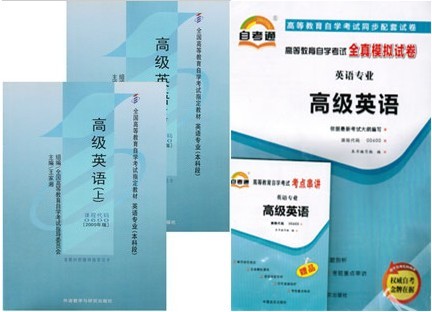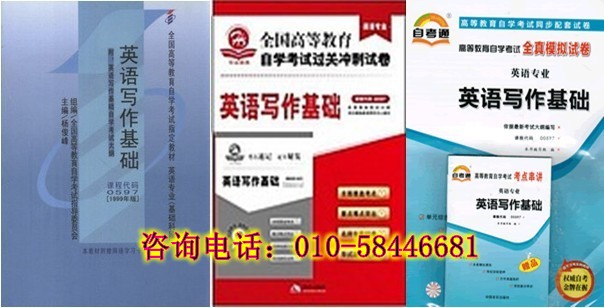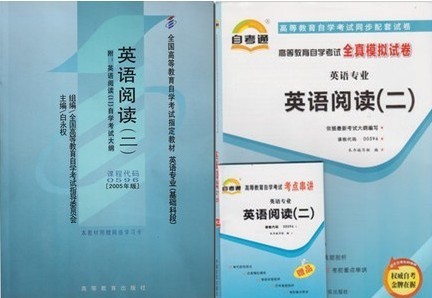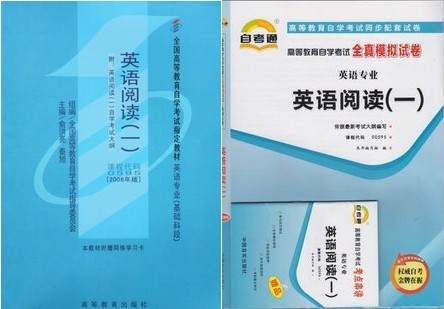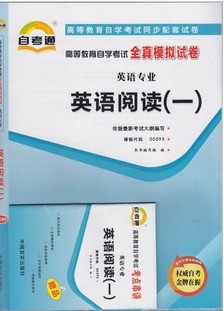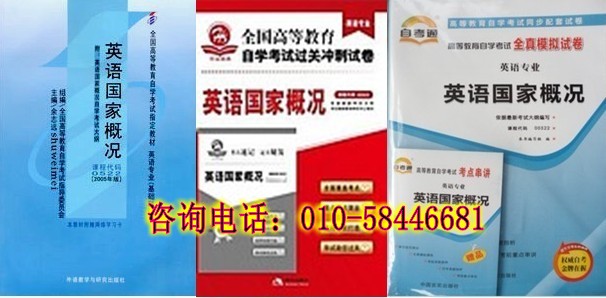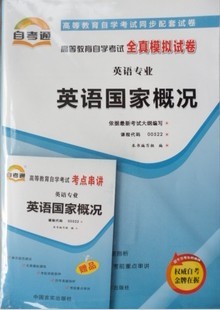
00831 现代英语语法考试教材+模拟试卷+冲刺试卷(共3本)
内容简介
00831 现代英语语法考试教材+模拟试卷+冲刺试卷(共3本)
包含:
00831 现代英语语法-自考教材 定价:21.9元
00831 现代英语语法-自考过关冲刺试卷(赠考点速记) 定价:20元
00831 现代英语语法-全真模拟试卷及历年试题汇编(自考通) 定价:20元
总计:61.9元
1、00831 现代英语语法-自考教材
本书作者:李基安
出 版 社:外语教学与研究出版社
出版日期:2000年4月第2版 2008年7月第15次印刷
开 本:32开
I S B N : 978-7-5600-1522-4
定 价:21.90
本书目录
Chapter 1 The Structure of the English Sentence
1.0 Introduction
1.1 Morphemes
1.2 Words
1.2.1 Word classes
1.2.2 Word-formation
a. Affixation
b. Composition
c. Conversion
d. Blending
e. Back-formation
f. Shortening
g. Acronyms
1.3 Phrases
1.3.1 The noun phrase
1.3.2 The verb phrase
1.3.3 The adjective phrase
1.3.4 The adverb phrase
1.3.5 The prepositional phrase
1.4 Clauses
1.4.1 Subject and predicate
1.4.2 Clause patterns
1.4.3 Functions
1.5 Sentences
1.5.1 Simple, compound and complex sentences
1.5.2 Statements, commands, questions and exclamations
1.6 The text
1.7 Exercises
Chapter 2 Sentence Types
2.0 Introduction
2.1 Statements
2.1.1 Assertion vs. non-assertion
2.1.2 Negation
a. Choice of negative words
b. Scope of negation
c. Transferred negation
2.1.3 Other functions of statements
2.2 Questions
2.2.1 YES-NO questions
2.2.2 WH-questions
2.2.3 Alternative questions
2.2.4 Tag questions
a. Forms and meanings
b. Irregular question tags
2.3 Commands
2.4 Exclamations
2.4.1 WHAT-exclamations
2.4.2 HOW-exclamations
2.5 Exercises
Chapter 3 Noun and Noun Phrase (1): Noun and Number
3.0 Introduction
3.1 Noun classes
3.2 Number
3.2.1 Singular invariables
a. Proper nouns
b. Mass nouns
3.2.2 Plural invariables
3.2.3 Irregular plurals
a. Irregular spelling/pronunciation
b. Zero plurals
c. Foreign plurals
d. Plural compounds
e. Plural of letters, numerals, abbreviations, etc.
3.3 Unit nouns
3.3.1 Unit nouns listed in alphabetical order
3.3.2 Unit nouns classified
3.4 Exercises
Chapter 4 Noun and Noun Phrase (2): Determiner and Genitive
4.1 Determiners
4.1.1 Functions of determiners
4.1.2 Co-occurrence of determiners
4.1.3 Usage of some determiners
a. all and whole
b. all and both
c. all, every and each
d. both, each and either
e. any, either, no (none) and neither
4.1.4 Articles
a. Pronunciation
b. Generic reference vs. specific reference
c. Indefinite article a (n)
d. Definite article the
4.2 Genitives
4.2.1 Forms of genitive
4.2.2 Genitive vs. of-phrase
a. Genitive
b. Of-phrase
c. Genitive and of-phrase
4.2.3 Group genitive
4.2.4 Local genitive
4.2.5 Double genitive
4.3 Exercises
Chapter 5 Verb and Verb Phrase (1): Tense, Aspect and Future
5.0 Introduction
5.0.1 Classification of verbs
5.0.2 System of two tenses and two aspects
5.1 Tense
5.1.1 Simple present
a. Simple present referring to the present
b. Simple present referring to the past
c. Simple present referring to the future
5.1.2 Simple past
a. Simple past referring to the past
b. Simple past referring to the present
c. Simple past referring to the future
5.2 Aspect
5.2.1 Present progressive
a. Present progressive referring to the present
b. Present progressive referring to the past
c. Present progressive referring to the future
d. Progressive verbs and non-progressive verbs
5.2.2 Past progressive
a. Past progressive referring to the past
b. Past progressive referring to the present or the future
5.2.3 Present perfect and present perfect progressive
a. Present perfect referring to a state, a habit or an event
b. Present perfect vs. simple past
c. Finished/unfinished use and present perfect progressive
d. Adverbials and constructions associated with present perfect
5.2.4 Past perfect and past perfect progressive
a. Finished/unfinished use and past perfect progressive
b. Hypothetical use of past perfect
5.3 Future
5.3.1 Will/shall do sth. (see 7.2 for more details)
5.3.2 Be going to do sth.
5.3.3 Present progressive
5.3.4 Simple present
5.3.5 Other constructions expressing future time
a. Will/(shall) be doing sth.
b. Be about to do sth.
c. Be to do sth.
5.4 Exercises
Chapter 6 Verb and Verb Phrase (2): Passive Voice and Subjunctive Mood
6.0 Introduction
6.1 Passive voice
6.1.1 Be-passive, get-passive and pseudo-passive
6.1.2 Voice constraints
a. Grammatical constraints
b. Semantic constraints
c. Stylistic constraints
6.1.3 By-phrase
6.1.4 Passive voice of multi-word verbs
a. Verb + preposition
b. Verb + particle
c. Verb + particle + preposition
d. Verb + noun phrase + preposition
6.1.5 Passive voice of non-finite verbs
6.2 Subjunctive mood
6.2.1 Be-subjunctive
a. Formulaic be-subjunctive
b. Mandative be-subjunctive
c. Other uses of be-subjunctive
6.2.2 Were-subjunctive
6.3 Exercises
Chapter 7 Verb and Verb Phrase (3): Modal Auxiliaries
7.0 Introduction
7.1 Can and may
7.1.1 Can/could
7.1.2 May/might
7.1.3 Can vs. may
7.2 Will and shall
7.2.1 Will/would(’ll/’d)
7.2.2 Shall/(should)
7.3 Should and ought to
7.3.1 Should
7.3.2 Ought to
7.3.3 Should vs. ought to
7.4 Must, need and have (got) to
7.4.1 Must
7.4.2 Need
7.4.3 Have (got) to
7.5 Dare
7.6 Exercises
Chapter 8 Verb and Verb Phrase (4): Non-finite Verbs
8.0 Introduction
8.1 Infinitive
8.1.1 Bare infinitive
a. Aux + verb
b. Idiomatic verb constructions
c. Rather/sooner than
d. Do
e. Why
8.1.2 To-infinitive
a. Verb + infinitive
b. Verb + object + infinitive
c. Verb + (object) + infinitive
8.1.3 Other uses of infinitive
8.2 -ing participle
8.2.1 Object to verb
8.2.2 Logical subject
8.2.3 Infinitive of –ing participle
a. Begin, cease, continue, start
b. Like, love, hate
c. Deserve, need, require, want
d. Remember, forget, go on
e. Mean, regret, try
f. Advise, allow, encourage, permit, recommend
8.3 -ed participle
8.3.1 -ed participle as a premodifier
8.3.2 -ed participle as a complement
a. Subject complement
b. Object complement
8.4 Dangling participle
8.5 Exercises
Chapter 9 Adjective Phrase and Comparison
9.0 Introduction
9.1 Syntactic features of adjectives
9.1.1 Structure of the adjective phrase
9.1.2 Attributive adjectives and predicative adjectives
a. Attributive adjectives
b. Predicative adjectives
9.2 Semantic classification of adjectives
9.2.1 Stative adjectives vs. dynamic adjectives
9.2.2 Gradable adjectives vs. non-gradable adjectives
9.2.3 Inherent adjectives vs. non-inherent adjectives
9.2.4 Restrictive adjectives vs. non-restrictive adjectives
9.2.5 Marked adjectives vs. unmarked adjectives
9.3 Ordering of premodifying adjectives
9.4 Comparison
9.4.1 Forms of comparison
a. Regular inflection
b. Irregular inflection
9.4.2 Usage notes
a. Elder and older
b. Farther and further
c. Less and fewer
d. Lesser
e. The
f. The more...the more...
9.4.3 Comparative constructions
a. As...as...
b. More...than...
c. The most...
9.4.4 Ellipsis in comparative sentences
9.4.5 Other expressions of comparison
9.5 Exercises
Chapter 10 Preposition and Prepositional Phrase
10.0 Introduction
10.1 Forms of prepositions
10.1.1 Simple prepositions
10.1.2 Complex prepositions
10.2 Meanings of prepositions
10.2.1 Prepositions relating to Place
a. At, on and in
b. Over, above, under and below
c. Between and among
d. Aboard the ship, etc.
e. From above, etc.
10.2.2 Prepositions relation to time
a. At, on and in
b. Time expressions without prepositions
10.2.3 Prepositions denoting other relations
10.3 Collocations of prepositions with verbs, adjectives and nouns
10.4 Exercises
Chapter 11 Coordination and Subordination
11.0 Introduction
11.1 Coordination
11.1.1 Coordinators
a. And and related coordinators
b. Or and related coordinators
c. But and related coordinators
11.1.2 Punctuation between coordinated units
11.2 Subordination
11.2.1 Subordinators
11.2.2 Subordinate clauses
a. Finite subordinate clauses
b. Non-finite and verbless clauses
11.2.3 Exercise
Chapter 12 Relative Clause
12.0 Introduction
12.1 Restrictiveness and non-restrictiveness
12.2 Antecedent
12.2.1 Nominal antecedent
a. Antecedent + restrictive relative clause
b. Antecedent + non-restrictive relative clause
c. Antecedent + restrictive/non-restrictive relative clause
12.2.2 Non-nominal antecedent
a. Clause as antecedent
b. Verb phrase as antecedent
c. Predicative adjective as antecedent
12.3 Choice of relative pronouns
12.3.1 Relative pronouns in restrictive relative clauses
a. Pronouns for personal antecedents
b. Pronouns for non-personal antecedents
c. Relative adverbs
12.3.2 Relative pronouns in non-restrictive relative clauses
12.4 Double relative clause
12.5 Exercises
Chapter 13 Adverbials
13.0 Introduction
13.1 Adjuncts
13.1.1 Time adjuncts
a. Types of time adjuncts
b. Positions of time adjuncts
13.1.2 Place adjuncts
a. Types of place adjuncts
b. Positions of place adjuncts
13.1.3 Proccess adjuncts
a. Manner-adjuncts
b. Instrument-adjuncts
c. Agentive-adjuncts
13.1.4 Contingency adjuncts
a. Reason-adjuncts
b. Result-adjuncts
c. Purpose-adjuncts
d. Concession-adjuncts
e. Condition-adjuncts
13.1.5 Other adjuncts
13.2 Disjuncts
13.3 Conjuncts
a. Enumeration-conjuncts
b. Addition-conjuncts
c. Transition-conjuncts
d. Summation-conjuncts
e. Explanation-conjuncts
f. Contrast-conjuncts
g. Result-conjuncts
h. Inference-conjuncts
i. Concession-conjuncts
13.4 Exercises
Chapter 14 Concord
14.0 Introduction
14.1 Principles of concord
14.2 Subject-verb concord
14.2.1 Collective nouns as subject
14.2.2 Coordinated noun phrases as subject
14.2.3 Expressions of quantity as subject
a. Subject with numerals
b. Subject with indefinite quantifiers
14.2.4 Nominal clauses as subject
14.2.5 Concord in the existential sentence
14.2.6 Concord in the relative clause
14.3 Pronoun concord
14.4 Exercises
Chapter 15 Information structure and Emphasis
15.0 Introduction
15.1 Information structure
15.1.1 Given and new information
15.1.2 Information focus
15.2 Postponement
15.2.1 Passive voice
15.2.2 Extraposition
a. Extraposed clausal subject
b. Extraposed clausal object
15.2.3 Discontinuity
15.2.4 Other types of postponement
15.3 Fronting
15.4 Inversion
15.4.1 Partial inversion
15.4.2 Complete inversion
15.5 Cleaving
15.5.1 Cleft sentence
15.5.2 Pseudo-cleft sentence
15.6 Existential sentence
15.6.1 Information structure of existential sentence
15.6.2 Grammatical features of existential sentence
15.7 Exercises
Chapter 16 Cohesion
16.0 Introduction
16.1 Reference
16.1.1 Reference by pronouns
16.1.2 Reference by demonstratives
16.1.3 Reference by comparison
16.2 Substitution
16.2.1 Nominal substitution by one
16.2.2 Verbal substitution by do
16.2.3 Clausal substitution by so or not
16.3 Ellipsis
16.3.1 Nominal ellipsis
16.3.2 Verbal ellipsis
16.3.3 Clausal ellipsis
16.4 Other cohesive devices
16.4.1 Transition
16.4.2 Repetition
16.4.3 Parallelism
16.5 Exercises
Appendix I Noun + Preposition
Appendix II Preposition + Noun
Appendix III Verb + Preposition
Appendix IV Adjective + Preposition
Bibliography
后记
2、00831 现代英语语法-自考过关冲刺试卷(赠考点速记)
作 者:华试精典教育研究中心
出版日期:2012年5月
印刷次数:1次
出 版 社:现代出版社
印刷时间:2012年5月
I S B N :978-7-5022-5008-9
开 本:16开
页 数:128页
印 张:8
原 价:20 元
《全国高等教育自学考试过关冲刺试卷》系列图书是华试经典教育研究中心推出的一套精品自考辅导用书。本系列试卷严格依照最新教材编写,各科试卷覆盖考试大纲中所列的重要考点,题型、题量参照最新真题设计,具有针对性强,实用高效的特点,争取为考生提供一条取得优异成绩的捷径。
本试卷具有以下特点:
知识点覆盖全面:严格依据大纲考点出题,每套自学考试过关冲刺试卷,涵盖近400个考点,网尽教材中的重点及历年真题中的常考考点。
内容设计合理:每册试卷题型、题量设计依据最新真题,参考答案部分标注教材页码,针对重点试题,附有详尽的解析,方便考生对照教材自学,满足考生科学学习的需求。
注重能力提高:每册试卷均由自考专家出题,出题角度与难度和自考真题相一致。在注重基础能力培养的同时,部分试题增加难度,提高考生解决问题的能力,旨在通过系统性练习,帮助考生既掌握教材知识,又提高自身能力。
实用而高效:考生可利用本套试卷检验自己日常学习的效果,也可以在考前进行模拟演练,对所学知识进行查缺补漏。
本书目录
过关冲刺试卷(一)
过关冲刺试卷(二)
过关冲刺试卷(三)
过关冲刺试卷(四)
过关冲刺试卷(五)
过关冲刺试卷(六)
过关冲刺试卷(七)
过关冲刺试卷(八)
过关冲刺试卷(九)
过关冲刺试卷(十)
过关冲刺试卷参考答案
3、00831 现代英语语法-全真模拟试卷及历年试题汇编(自考通)
出版日期:2012年5月
印刷次数:1次
出 版 社:中国言实出版社
印刷时间:2012年5月
作 者:丛书编写组
I S B N :978-7-80250-550-6
开 本:16开
页 数:120页
印 张:8
原 价:20 元
本套“全真模拟试卷及历年试题汇编”具有以下特点:
命中率高:自考命题专家根据最新题型编写预测试题,命中率高达85% 。
内容新:本套丛书全部按最新的自学考试大纲内容编写,知识详尽,重难点分明,有助于考生对考试内容作全局性的掌握。
题型新:本套丛书以章为单位,依据最新考试题型编写了“章节同步练习题”,所有试题命题科学、解答准确。书后所附的模拟试题也和自考实际考题的题型、题量完全一致。
信息全:本套丛书覆盖了自考大纲中所有的考核点。特别需要指出的是,近年来自考大纲重新调整,本套丛书对有关知识内容做了详尽补充。
作者阵容强:本套丛书的作者,有指定教材的主编,有专业教研室主任,有长期参加辅导的高校一线教师。他们对自考教材分析透彻,对命题规律掌握准确。
配套服务高:购买本套丛书的读者均可获赠超强体验K币,免费下载海量真题,在线模拟考场以全真考场形式赋予考生临场实战体验,网络课程笔记对考生进行考前串联性知识点拨,能使考生在真正的自考中知己知彼,百战百胜。
全方位综合演练:本套试卷共包含单元综合测试,全真模拟演练,考前深度密押,2套历年最新试题.根据学习的不同阶段,精心策划试题类型,紧跟历年自学考试的主旨和方向,全方位立体式丰富您的知识,使您自考轻松过关。
详尽的试题解析:在每套试卷的答案处,都附带有对重点题目的详细解析,简单易懂,准确透彻。同时,还附有仿真考试例题,举一反三,使您很快心领意会,如同名师面对面讲解。
高价值增值服务:随书赠送64开小本名师精华串讲,将自考知识的主题和精髓凝结其中,提供挈领,凸显主要的考试内容,携带方便,您可以随时随地翻阅学习。
本书目录
单元综合测试(卷)+全真模拟演练(卷)+考前深度密押(卷)+历年真题
参考答案及解析(试题答案+考点单击+要点透析)
随试卷赠送考点串讲(串讲小本)
2套(2010年4月,2011年4月)真题及解析
温馨提示
欢迎您选择北京考试书店,在这里,我们向您承诺,本书店出售图书均为正版图书,请您放心购买!
如您在下订单的时候遇到难题,欢迎您随时咨询我们的客服人员;
咨询热线:13520801473;在线QQ:1119846269;
如您对我们的书店有任何建议,欢迎您发邮件给我们,我们的邮箱:service@bookskys.com
北京考试书店祝您购物愉快!
如您在下订单的时候遇到难题,欢迎您随时咨询我们的客服人员;
咨询热线:13520801473;在线QQ:1119846269;
如您对我们的书店有任何建议,欢迎您发邮件给我们,我们的邮箱:service@bookskys.com
北京考试书店祝您购物愉快!
汇款账号
汇款户名:庹珍珍
中国工商银行帐号:6222 0202 0004 8271 965
中国农业银行帐号:6228 4800 1051 6883 112
中国银行帐号:6013 8201 0001 5744 736
中国邮政银行帐号:6221 8810 0006 5935 785
中国建设银行账号: 6227 0000 1286 0174 562
支付宝账号:tuozhenzhen88@126.com
中国工商银行帐号:6222 0202 0004 8271 965
中国农业银行帐号:6228 4800 1051 6883 112
中国银行帐号:6013 8201 0001 5744 736
中国邮政银行帐号:6221 8810 0006 5935 785
中国建设银行账号: 6227 0000 1286 0174 562
支付宝账号:tuozhenzhen88@126.com
相关图书
英语专业分类
推荐图书
- ·05844 国际商务英语考试教材+模
- ·00832 英语词汇学考试教材+模拟
- ·00831 现代英语语法考试教材+模
- ·00795 综合英语(二)考试教材+
- ·00795 综合英语(二)-自学考试
- ·00794 综合英语(一)考试教材+
- ·00794 综合英语(一)-自考过关
- ·00604 英美文学选读考试教材+模
- ·00603 英语写作考试教材+模拟试
- ·00600 高级英语(上下册)考试教
- ·00597 英语写作基础考试教材+模
- ·00596 英语阅读(二)考试教材+
- ·00596 英语阅读(二)-自学考试
- ·00595 英语阅读(一)考试教材+
- ·00595 英语阅读(一)-自学考试
- ·00522 英语国家概况考试教材+模
- ·00522 英语国家概况-自学考试全
- ·00088 基础英语(上下册)考试教
- ·00088 基础英语-自学考试全真模
- ·00087 英汉翻译教程考试教材+模
考试资讯
- ·2013年4月吉林省自考报名时间
- ·2013年内江市4月自学考试报名时间
- ·2013年广西柳州注册税务师考试报名
- ·重庆2013年社会工作者考试报名时间
- ·2013年黑龙江注册税务师考试报名时
- ·2013年湖北社会工作者考试报名时间
- ·2013年福建社会工作者考试报名时间
- ·湖北2013年质量工程师报名时间3月
- ·兵团2013年质量工程师报名时间2月
- ·福建2013年质量工程师报名时间2月
- ·2013年兵团社会工作者考试报名时间
- ·普洱2013年社会工作者考试报名2月
- ·保山2013年社会工作者考试报名2月
- ·2013年河北张家口注册税务师考试报
- ·2013年河北保定注册税务师考试报名
- ·2013年湖北社会工作者考试报名为3
- ·吉林2013年注册咨询工程师考试报名
- ·2013年宜昌职称计算机考试报名时间
- ·金华2013年二级建造师考务通知
- ·温州2013年二级建造师考务通知

